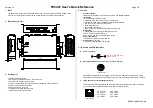
9
4 Mounting
Conductive probe EL 2 •
54461-EN-220324
4 Mounting
4.1 General instructions
In general the level switch can be mounted in any position. The instru-
ment must be mounted in such a way that the probe is at the height of
the requested switching point.
The probe is provided with a special hexagon for tightening. Due to
the hexagon shape, the housing itself can be used to screw the instru-
ment in.
The wrench size is stated in chapter "
Supplement
" under "
Dimen-
sions
".
Use the recommended cables (see chapter "
Connecting to power
supply
") and tighten the cable gland.
You can give your instrument additional protection against moisture
penetration by leading the connection cable downward in front of the
cable gland. Rain and condensation water can thus drain off. This
applies mainly to outdoor mounting as well as installation in areas
where high humidity is expected (e.g. through cleaning processes) or
on cooled or heated vessels.
Fig. 2: Measures against moisture ingress
Do not hold EL 2 on its electrode rods. Particularly with long rod ver-
sions, the sensor can be damaged by the weight of the instrument.
The process fitting must be sealed if there is gauge or low pressure
in the vessel. Before use, check if the sealing material is resistant
against the measured product and the process temperature.
The max. permissible pressure is specified in chapter "
Technical
data
" or on the type label of the sensor.
4.2 Mounting instructions
Due to agitators, equipment vibration or similar, the level switch can
be subjected to strong lateral forces.
Extreme vibration caused by the system, e.g. due to agitators or
turbulence in the vessel from fluidisation, can cause the probe of EL
2 to vibrate in resonance. If a longer rod version is necessary, you can
secure the probe by fastening a suitable isolated brace or guy directly
above the end of the rod.
Switching point
Handling
Moisture
Transport
Pressure/Vacuum
Agitators and fluidization






































